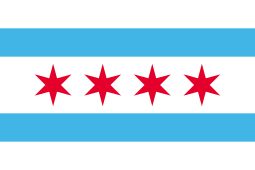 |
| Chicago Flag |
The bottom blue stripe represents the South
Branch of the river and the canal.
The four six-pointed red stars represent major
historical events:
·
Fort
Dearborn,
·
The Great
Chicago Fire of 1871,
·
The World's
Columbian Exposition of 1893, and
·
The Century
of Progress Exposition of 1933–34.
• The first star represents Fort Dearborn. It
was added to the flag in 1939. Its six points symbolize transportation, labor,
commerce, finance, populousness, and salubrity.
• The second star stands for the Great Chicago
Fire of 1871, and is original to the 1917 design of the flag. Its six points
represent the virtues of religion, education, aesthetics, justice, beneficence,
and civic pride.
• The third star symbolizes the World's
Columbian Exposition of 1893, and is original to the 1917 design. Its six
points stand for political entities Chicago has belonged to and the flags that
have flown over the area: France, 1693; Great Britain, 1763; Virginia, 1778;
the Northwest Territory, 1789; Indiana Territory, 1802; and Illinois
(territory, 1809, and state, since 1818).
• The fourth star represents the Century of
Progress Exposition (1933–34), and was added in 1933. Its points refer to
bragging rights: the United States' second largest city (became third largest
in a 1990 census when passed by Los Angeles); Chicago's Latin motto, Urbs in
horto ("City in a garden"); Chicago's "I Will" motto; the
Great Central Marketplace; Wonder City; and Convention City.